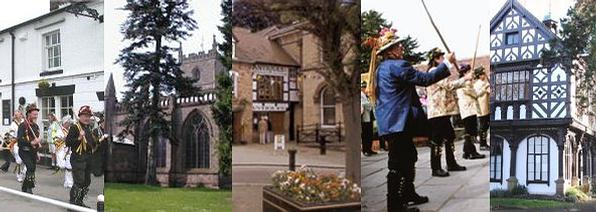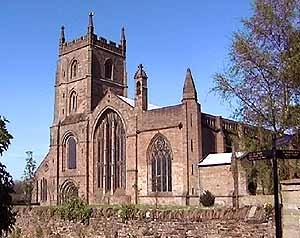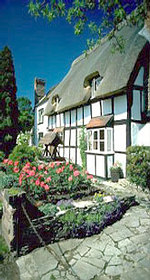
The Local Time is Saturday, 27-Jul-2024 13:23:39 CEST
Leominster Tourist Information and Travel Guide |
|
||||
| YOU ARE HERE: Main Home Page > Herefordshire > Leominster |
|
|
|
|
|
|
 |
|
Tour and Tourist Information Guide for the Market Town of Leominster in the County of HerefordshireThe charming town of Leominster has much to offer the visitor. Famous for its many antique shops, medieval streets and alleys, cafes and specialist shops, the town has a popular busy market every Friday in the Corn square and Farmers Market twice a month. Regular antique auctions are held at Brightwells. Leominster's Priory Church towers above this delightful market town and is famed for its 45-foot perpendicular window and ducking stool. | |||||||||||||||||||||
 |
|||||||||||||||||||||
Leominster |
|||||||||||||||||||||
|
|||||||||||||||||||||
A History of Leominster, HerefordshireThe town of Leominster, is these days renowned for its large number of antique shops, but there is a high degree of antiquity in the town itself. Below is a history of the town & and a handy map & town guide is presented below. History Leominster lies in the heart of the Marches, the beautiful and historic borderlands of England and Wales. The town dates from the 7th Century, and its name (pronounced Lemster) may derive from Leofric, Earl of Hereford and husband to Lady Godiva.The town's strategic position has made it vulnerable to attack, and it was held by both the Welsh and the Danes before being taken for Edward the Confessor by Harold Godwinson (later King Harold). In 1461 the decisive battle of the Wars of the Roses, the battle of Mortimers Cross, took place a few miles from the town. Despite the area's turbulent history, Leominster prospered in the medieval period. The town's wealth arose primarily from the wool trade, owing to the superlative quality of the wool of its local Ryeland sheep. The fleeces came to be known as 'Lempster Ore' (Leominster Gold). Much of the town centre still retains its medieval and Tudor flavour - narrow streets and half timbered houses with jetted out overhanging first storeys. School Lane, Drapers Lane and High Street all contain good examples of such buildings. Church Street and Etnam Street boast the wide streets and gracious terraces of the Georgian period. Grange Court A magnificently carved building of 1633 by John Abel, The King's carpenter. Formerly the Town Hall situated where Burgess street and Broad Street meet. Dismantled in 1852 by Act of Parliament to remove traffic obstructions. It was sold by auction in 1853 for £95.00. Re-sold for the same price on the same day it was later re-erected on its present site as a private home. It became Council Offices in 1938/39 to prevent its export to the USA. The Chequers Inn Certainly dating from around 1600 and possibly going as far as 1480, this is one of England's finest examples of an early timber framed Inn. Hester Clark's Almshouses Founded in 1735 for 'four decayed widows" this unusually decorated building has on its face a foundation plaque and a whimsical figure of an axeman with lines "He that give away all before he is dead, let them take this hatchet and knock him on ye head". The Priory Church A nunnery in 660 A.D. it was rebuilt in the 12th century. The unique tower has work of early Norman, Transitional, Early English, Decorated and Perpendicular periods. The reformation of 1539 led to partial destruction. Inside are many fine features including England's last used ducking stool and a beautiful 15th century chalice. Lion House Formerly the Red Lion Hotel, an important coaching inn and wagon centre. It still carries one of the stone lions at roof level. The elegant ballroom has been restored to Regency glory by the present owners. In 1808 mail coaches went to Bristol and Holyhead delivering letters en route faster than today's service. The Forbury Built in 1284, this chapel was later dedicated to Thomas a Becket. It contains some fine medieval roof timbers. In the 19th Century it served as a rather unlikely music hall for the town. 7. The Three Horseshoes Situated in Corn Square market place, this plain timbered building combines with the gift shop across School lane in a perfect medieval flavour. The Old Priory Hospital Originally the Infirmary & Reredorter of the Benedictine Priory. As part of the once great monastic complex it still portrays the wealth and strength of the Church of those times. School Lane Looking along the narrow street the typically medieval steep roofs and deep jetties, hidden when walking along the street itself, can be seen to advantage. The town retains much of its ancient road patterns and purity of character. Dutton House A Tudor house lies behind 1850 Gothic exterior. Once Safferton House and renamed after John Dutton, 6 times MP for Leominster, who acquired it in 1670. Opposed to Catholic King James II he was tried for treason in 1684 and fined £10,000. He hid in a secret chamber within the existing Tudor fireplace. |
|||||||||||||||||||||
| BACK TO TOP | |||||||||||||||||||||
|
|||||||||||||||||||||
|
|||||||||||||||||||||
|
|||||||||||||||||||||
The Market town Leominster of in Herefordshire |
|||||||||||||||||||||
| This page last modified Tuesday, 28-May-2019 10:59:32 CEST | |||||||||||||||||||||
 lies to the north in the heart of the Marches, the beautiful borderlands of England and Wales.The town dates from the 7th century and its history can be seen throughout the town, The 11th century Priory Church which is renowned for having three naves, a 45 foot perpendicular window and a well preserved 'ducking stool', was in use up to early 19th century, to 'still the tongues of nagging women'! and towers above this delightful Market Town. The town is rich in historic buildings,The narrow streets and timber framing retain much of the mediaeval and Tudor characteristics. when Market day arrives Corn Square is thronged with people around the stalls. Antique shops are the town’s specialty ranging from cheap and cheerful to fine art auctions.and you will find many Antique shops improving your chance of finding real bargains.
lies to the north in the heart of the Marches, the beautiful borderlands of England and Wales.The town dates from the 7th century and its history can be seen throughout the town, The 11th century Priory Church which is renowned for having three naves, a 45 foot perpendicular window and a well preserved 'ducking stool', was in use up to early 19th century, to 'still the tongues of nagging women'! and towers above this delightful Market Town. The town is rich in historic buildings,The narrow streets and timber framing retain much of the mediaeval and Tudor characteristics. when Market day arrives Corn Square is thronged with people around the stalls. Antique shops are the town’s specialty ranging from cheap and cheerful to fine art auctions.and you will find many Antique shops improving your chance of finding real bargains.
